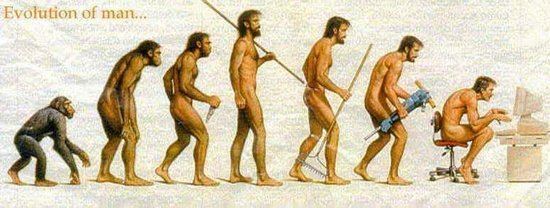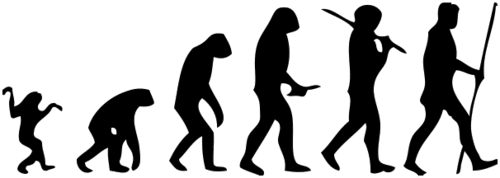Artist Rudolph F. Zallinger | ||
 | ||
Threshold ashes march of progress 2012
The March of Progress, or simply March of Progress, is a scientific illustration presenting 25 million years of human evolution. It depicts 15 human evolutionary forebears lined up as if marching in a parade from left to right. The image has frequently been copied, modified and parodied, and has been the subject of controversy.
Contents
- Threshold ashes march of progress 2012
- Viet cong march of progress
- Original intent
- Original sequence of species
- Criticism
- Parodies and adaptations
- Predecessor
- References

The illustration was commissioned by Time-Life Books for the Early Man volume (1965) of its popular Life Nature Library. This book, authored by anthropologist F. Clark Howell (1925–2007) and the Time-Life editors, included a foldout section of text and images (pages 41–45) entitled "The Road to Homo Sapiens", prominently featuring the sequence of figures drawn by natural history painter and muralist Rudolph Zallinger (1919–1995). The first two sentences of the caption to the illustration read (with emphasis added), "What were the stages of man's long march from apelike ancestors to sapiens? Beginning at right and progressing across four more pages are milestones of primate and human evolution as scientists know them today, pieced together from the fragmentary fossil evidence." Although the context indicates that it was not the authors' or illustrator's intent to imply a linear ancestor-descendant parade, as the popularity of the image grew and achieved iconic status, the name "March of Progress" became attached to it.

Paleoanthropologists have noted that early human evolution did not progress in any linear, sequential fashion nor did it move along a "road" toward any predetermined "ideal form"; they have faulted the image with being misleading in implying these things. With regard to the picture's notoriety, Howell remarked: "The artist didn't intend to reduce the evolution of man to a linear sequence, but it was read that way by viewers. ... The graphic overwhelmed the text. It was so powerful and emotional".

Viet cong march of progress
Original intent

Contrary to appearances and some complaints, the original 1965 text of "The Road to Homo Sapiens" reveals an understanding of the fact that a linear presentation of a sequence of primate species, all of which are in the direct line of human ancestors, would not be a correct interpretation. For example, the fourth of Zallinger's figures (Oreopithecus) is said to be "a likely side branch on man's family tree". Only the next figure (Ramapithecus) is described as "now thought by some experts to be the oldest of man's ancestors in a direct line" (something no longer considered likely). This implies that none of the first four primates are to be considered actual human ancestors. Likewise, the seventh figure (Paranthropus) is said to be "an evolutionary dead end". In addition, the colored stripes across the top of the figure that indicate the age and duration of the various lineages clearly imply that there is no evidence of direct continuity between extinct and extant lineages, and also that multiple lineages of the figured hominids occurred contemporaneously at several points in the history of the group.
Original sequence of species
The 15 primate figures in Zallinger's image are, from left to right, as follows (the datings follow the original graphic and may no longer reflect current scientific opinion):

Criticism
The march of progress is the canonical representation of evolution – the one picture immediately grasped and viscerally understood by all.... The straitjacket of linear advance goes beyond iconography to the definition of evolution: the word itself becomes a synonym for progress.... [But] life is a copiously branching bush, continually pruned by the grim reaper of extinction, not a ladder of predictable progress.
Gould reproduces several advertisements and political cartoons incorporating the March of Progress to convey one message or another. He even presents a "personally embarrassing" example: one of the four foreign editions of his books (over the design of which he had no control) which used the "march of human progress" as a jacket illustration. Gould never actually mentions Zallinger or the Time-Life Early Man volume in his critique, giving only vague clues as to the origin of the concept.Parodies and adaptations
Predecessor
An illustration, with the caption "Evolution," showing two sequences of four images, each illustrating a gradual transformation of an animal into a human, appeared in the 1889 edition of Mark Twain's A Connecticut Yankee In King Arthur's Court:
